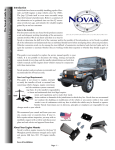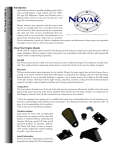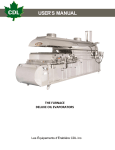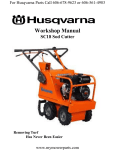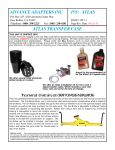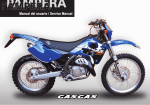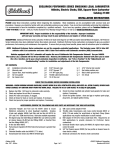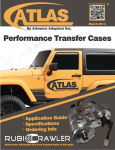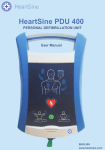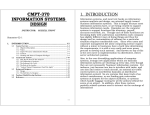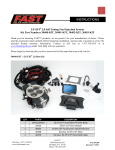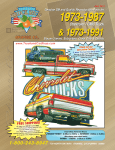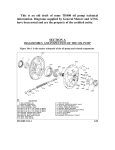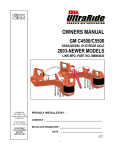Download Installing GM Generation III+ Engines in CJ Universal Jeeps
Transcript
Installing GM Generation III+ Engines in CJ Universal Jeeps The Novak Guide to Introduction Individuals have been successfully installing popular Chevrolet and GM engines to Jeep vehicles since the 1960’s. The Jeep CJ lends itself to very successful Generation III+ swaps. Below is a summary of the information we’ve gathered over many years, and includes the valuable insights gained by us and our customers Note to the Installer This document and the use of any Novak products assumes a safe and adequate working knowledge of the automotive systems involved. We do not know and there is no way for Novak to determine the skill level of the customer and/or the installer of Novak products, or for Novak to publish all of the information on fundamentals that an individual should know before attempting these advanced procedures. Vehicular conversion work can be among the most difficult of automotive mechanical and electrical tasks and it is upon the customer to ascertain whether they are working within their expertise or whether they should acquire assistance. This guide is not intended to replace the service manual specific to your vehicle. It is not possible to document the wiring, routing and specific system details of every Jeep and the installer should obtain use both their vehicle’s manual and the engines donor vehicle’s manual in conjunction with these instructions. Novak products and procedures are intended and recommended for off-road use only. Your Local Legal Requirements This guide is not meant to explain, interpret or notify the installer of local or national laws concerning vehicle changes, engine conversions and the emissions systems surrounding them. It is the installer’s responsibility to know and understand their local legal requirements and regulations and to make their installation conform to demands of the jurisdictions in which they live. Novak does not recommend nor condone the disabling or modification of the vehicle or any system within it that could render it out of conformance with any laws in which the vehicle may be licensed or operate. Neither Novak Conversions nor its directors, principles or employees are responsible for any changes made to your vehicle. We recommend you consult and know your own city, county, state or countries laws. If your vehicle requires referee inspection, you may wish to establish a rapport with a referee and discuss your plans and seek advice and approval from them. American Made About Your Engine Mounts Novak’s bolt-in / weld-in engine mounts for the 19721986 Jeep CJ provide immense strength and a rapid and precise GM Gen. III+ V8 engine installation. Ease of Installation With the engine mounts discussed in this instruction guide, we have sought to achieve the greatest ease of Page - - A Project Strategy Warning installation without compromising engineering. Strength The Novak mounts feature a thick 3/16 steel construction and a welded box design for the maximum strength available. They employ the best engineering and geometry to assure that they’ll survive even the wildest of engines. Placement We have predetermined engine placement for the installer. There is a very fine window in which these GM engines can properly fit into a YJ Jeep, and we’ve done this design legwork already. Compactness The mounts will clear the blockhugging exhaust headers we recommend and clearance from all other retained factory components is also excellent. Note that sagging factory springs and / or modified axle bump stops, combined with mounting the engine too far forward could allow for axle interference with the engine oil pan. It is the responsibility of the installer to verify a safe and non-interfering installation. Vibration Isolation Each mount kit comes with our high-grade isolators that are gauged well for that ideal balance of isolation and firmness. The large, graded 5/8” bolts and all associated hardware are included. Additionally, Novak will always be here to inexpensively provide replacement isolator bushings, if needed - years down the road. Conversions have most commonly been best performed by the Jeep owner and enthusiast as it’s rare to find anyone who cares more about good work than they do. We’ve seen some terrific and solid work come out of owners / installers and also their hired mechanics. We’ve also seen or heard of projects go badly, and unneccessarily and too often because the “professionals”, well, aren’t. This ranges from bad technical advice to doing just plain shoddy work. The pretense of adequate knowledge by installers or mechanics can kill an otherwise great project. Wisely choose what assistance you may need. Be skeptical of any who claim of great conversion and wiring work without seeing a portfolio or references from a technician’s customers for whom they’ve done similar custom work. We cannot stress enough that a good powertrain repair technician may not necessarily be a good engine conversion technician. The owner / installer may choose - based on their own skills and project preferences - to delineate the scope of their work versus the assistance they hire, e.g., mechanical installation versus electrical, etc. Lastly, it’s also good policy to limit the scope of work being performed. Draw a line in the sand and try limit the conversion to itself, keeping body, chassis, interior and other restoration and upgrade projects separate until the powertrain swap is successfully done. Failure to plan and execute the project correctly can add great and wasted expense and give unsatisfactory results. Preliminaries Body & Suspension Lifts Contrary to conversion mythology, it is not necessary to install a body lift when installing a Chevrolet Small Block or GM Gen. III+ engine in a CJ. It is also not necessary to install a suspension lift or extended suspension snubbers for the purpose of the conversion. A GM V6 & V8 can be installed in a factory CJ Jeep so long as the factory springs are not excessively fatigued or collapsed. Air Conditioning The CJ frame is wide enough to allow for the retention of all known Gen. I - III+ A/C compressors. The A/C circuits will plug into the factory CJ or aftermarket cooling system. You may seek the assistance of your cooling specialty shop to make the connections as required. If you are wishing to run an onboard air compressor without losing A/C, we recommend that you install our Air Conditioning Relocation kit, which provides a new compressor and mounts it up at the passenger side head location on Gen. III+ engines. Preparation Details Make sure that all A/C and heater circuits are plugged off to prevent ingress of contaminants. Few things will add to your enjoyment of the project as much as a good pressure washing of the engine bay while it is open. Gauges All of the OEM CJ gauges can function very well with the GM engine with the following six major points of notation that the gauges need to operate: Page - - Speed All 1972-1986 CJ’s used a cable speedometer from the Jeep Dana 20 or Dana 300 transfer cases. Just leave this connected as per factory. If you are doing an electronically controlled automatic installation such as with the 4L60E (very common with Gen. III+ engines), Novak’s transfer case adapter assembly features an independant speed signal for the GM PCM to propery operate. If you are utilizing a manual transmission or classic automatic (TH350, TH400, 700R4, etc) , run a speed signal generator with a speedometer cable-through option. These senders generate enough of a signal to notify the PCM of driving speeds enough to put the engine into true closed loop. This aftermarket variable reluctance speed signal generator will send a pulsed speed signal to the GM PCM from the transfer case speedometer gear, while allowing for speedometer cable pass-through if you’re retaining your factory mechanical speedometer. Tachometer 1972-1986 CJ’s used a conventional distributor signal with the AMC engines to the tachometer, if equipped. GM tach outputs vary, but few are compatible with the Jeep CJ factory gauge. To solve this, use a tachometer interface module, such as the Dakota Digital #SGI-8, which can calibrate your factory tachometer to your GM engine. Oil Pressure GM engines conveniently offer extra ports for oil pressure. The factory GM one to the PCM should obviously remain. The original Jeep sensor on the factory harness from its outgoing engine can be installed into another port. A popular installation point is in the oil filter adapter area, as depicted in the adjacent image. This fitting can be tapped as per the threads of the original Jeep sender. Water Temperature Just like for the oil pressure sender above, the original Jeep sender can be threaded into the heads, or even an extra port in the conversion radiator, though adapting with fittings may be required. Careful, non-contaminating tapping of the GM block / heads may be required. Voltmeter This is the simplest of them all. The voltage signal is provided by the 12v current going across the wire harness. No changes are required here. Fuel Level A fuel level signal is provided by the factory Jeep Fuel Level Sending Unit. While you may be swapping out this sending unit for a an in-tank fuel injection pump, the signal will be the same. For your reference, Jeep CJ fuel senders from 1976 read 73 ohms empty and 12 ohms full. Do pay exteme caution when working with electrical connections in the areas of fuel and fuel vapors, as a spark can ignite and cause death, massive injury and property damage. Aftermarket Gauges An alternative to the above factory gauge strategy is to use aftermarket gauges. These can all read from independent sensors as per the above strategy, and/or use the feeds off the GM PCM, and/or read the CAN bus network signal off the GM PCM, all as per the recommendations and instructions of the gauges manufacturer. Page - - Note the location of the Jeep oil pressure sensor on this Gen. III+ engine (above) and the water temperature sensor (below). It may be necessary to drill and tap as per the threads in your factory or aftermarket sensor. Jeep Transfer Cases This guide is based on the retention of the original Dana transfer cases in your Jeep. They are extremely reliable, very durable, and easily and affordably adapted to your conversion powertrain. Your Powertrain Assembly If you have purchased a Novak Turn-Key powertrain, you can skip the following preliminary step. It is recommended that you pre-assemble your powertrain outside of the Jeep. Follow the instructions provided with your Novak adapter kit to assemble your chosen gearboxes behind your GM engine. You should assemble the powertrain as completely as possible, including the headers, wiring, accessories, belts, clutch releases, air intakes, etc. At Novak, we actually pre-assemble and test run our powertrains prior to installing them into the Jeep. If you assemble as much as the powertrain as you can and follow this same paradigm, asking the question, “Given battery, fuel and coolant, could I run this engine on a test stand?”, you will be well on your way. Because of superior access to things and for organizational purposes, you will enjoy the work more and take a few hours off of your project. This section precedes the others in that it is a very good idea to have the powertrain assembled to the fullest extent possible prior to disabling your Jeep for the conversion process. Begin the Conversion We’ll begin by disconnecting the negative battery cable and by then disconnecting the coolant, fuel, air, vacuum, exhaust and electrical circuits into the engine. Once the coolant is drained, remove the radiator, A/C condenser, transmission cooler, any winches, etc. Now, remove the grille from the fenders and front crossmember. It is not necessary to remove the hood, as it may be tilted fully out of the way against the windshield frame. Powertrain Removal It is usually recommended to remove not just the engine, but the transmission and transfer case, even if you are retaining both of them in your conversion, such as with the T18, T14, T15, T150 and T176 manual transmissions. Because the GM engine will relocate the geartrain forward by about 2-1/2” to 3” forward, removal and assembly to your new engine outside of the Jeep is generally helpful and not difficult. Drop the crossmember / skidpan assembly, supporting the transmission and transfer case with jack stands. Disconnect the front and rear driveshafts and set them out of the way. If your fluid is due for change, drain the transfer case fluid. You may wish to do the same for the transmission. Page - - Disconnect the transfer case shifter and speedometer connection. Remove the transfer case from the factory transmission adapter and set it aside. Note here that it is possible to remove the transfer case with the engine and transmission assembly as you thread them up and out of the engine bay. However, generally, it is easy to remove the transfer case. Disconnect the transmission shifter assembly from its housing. This is typically done by removing its four bolts that secure the shifter assembly to the top of the transmission. Disconnect the hydraulic clutch release line. Unbolt the factory engine mounts from the frame horns. Safely secure a lifting jig to your outgoing motor and carefully pull it from the bay. Typically, the transmission causes the powertrain to tilt back and allows it to feed out from the engine bay at the proper angle, but having an assistant or two to guide it out is helpful. Firewall Clearance No firewall modifications are required. Clearance with GM V8’s is excellent and anyone having to modify their firewall has installed the engine in the wrong location. Engine Mounts Engine Plate Installation In preparation for the installation mount the provided engine block mount plates onto the engine block bosses. Insert the provided carriage bolt through the center hole of the block plate. Notice that these engine plates are adjustable fore and aft with three conjoined holes. We recommend you install them in the center hole location at first, and then adjust forward if you have sufficient fan / radiator clearance. Use the eight factory or Novak-provided M10 (Gen III+) or 3/8” (Gen I-II) bolts. We recommend the installer use a drop of removable thread locking compound on these threads, such as Loctite Blue upon final installation, and torque to ~35 ft. lbs. Slide the upper isolator onto the carriage bolt, with the radiused cup side towards the engine block. Note that the engine plate hole is radiused to allow the carriage bolt to droop downward. This will ease your installation as the engine is lowered into the mounts. At this point, we recommend that you temporarily wrap the carriage bolt threads with two or three wraps of vinyl tape. This will help keep the upper isolator from sliding off during assembly. Page - - Frame Preparation These mounts are a bolt-in / weld-in design when replacing any of the factory CJ engines. They require the complete removal of the factory frame horns which will be replaced by the frame brackets as provided in the Novak kit. Total removal of the factory I4, I6 or V8 frame horns and steering shaft support bracket is required. We recommend a reciprocating saw with appropriate speed and blade, or a plasma cutter. Follow up with a clean grind or disking of the frame. Install the Engine Mounts Your Novak engine mounts predetermine the location of your GM engine, for height, left-right offset and longitudinal position. You’ll notice that one mount is wider than another. This is the passenger’s side mount. You’ll also notice the mounts are cut to match the wall and contour of the Jeep CJ frame. Position the mounts on the frame in alignment with the six bolt holes provided and install the mounts with the provided 3/8” bolts, torquing to ~35 ft. lbs. We’ve found this to be the ideal position for the widest variety of Generation III+ conversion circumstances. While we have determined the engine location based on a variety of installation scenarios, you may wish to temporarily tack weld the brackets to the frame rails and do a test installation of your own V8 engine and verify any particulars to your installation, such as transmission fit, radiator fit, accessories, cooling system, etc. Once you’re content with it all, lay MIG or stick welds along the top ear’s edge to the of the Novak brackets for a maximum strength connection to the Jeep frame. Allow your frame and bracket to air cool. Do not accelerate the cooling process with compressed air or water. We suggest you follow up by wire brushing and coating the brackets with primer and enamel as per your preference. Install the Powertrain It’s now time to finally lower your motor into the Jeep engine bay if you haven’t already done so. Very carefully and with assistance, lower your powertrain into the engine bay. You can thread your transfer case into the Jeep tunnel with someone guiding it. Lower in your new engine. Install the underside isolator mounts and install the provided TopLock nuts under the isolator bushings. Do not squish the bushings. Tighten them only to where they just start to deform. Overly tight bushings can cause excessive engine vibrations through the Jeep and will cause premature bushing cracking and failure. Page - - Steering The GM power steering pump will drive the Jeep power steering gear perfectly well. You may need to have a hydraulic shop or parts house make you a high-pressure line that matches the CJ power steering gear and the GM power steering pump. The return line is simply low-pressure 3/8” hose, as is available from your local parts house. If you’re feeling creative, you can even run this line through an external cooler to add to the life of your pump and gear in hard service situations. Brakes You can retain your factory braking system all together. No changes are necessary from the standpoint of the conversion itself. The GM engine provides vacuum at the rear of the manifold, whether it be a Small Block Chevy or a GM Gen.III+. It may be necessary to tap for a simple, barbed brass fitting on some manifolds that had the Hydroboost brakes. Cooling System The Jeep radiator will be both inadequate, poorly configured for a GM engine and has a reputation for a lack of durability. The Novak Radlock Radiator is a tough and very efficient radiator. It is a cross-flow design and it bolts into the CJ grille without mods. With it, we have seen success with the following coolant hoses: Lower may be Napa #7473 or try a Gates #20842 or #21706. For the upper, try a Gates #21833. We have also used Gates hoses #22438 and #22437. It is possible to run a mechanical fan and they almost always have plenty of pulling power. Electric fans are becoming more of the norm. We recommend our aggressive electric fan with integrated shroud assembly. These fans are controlled by any GM computer equipped with a circuit to trigger a fan relay. Alternatively, Page - - you can install a fan control module and install it to our fan motor per the manufacturer’s recommendations. Exhaust CJ Jeep exhaust systems are not difficult to run at all. It might be possible to use some factory manifolds with your conversion engine. The CJ has an adequate engine bay, but there are still space limitations. As such, we generally recommend aftermarket headers for compatibility as well as performance. We recommend our #CCLS1 headers for Gen.III+ engines and our #CC158 headers for Chevrolet Small Block V8’s for optimal layout. Run the driver’s side down and in front of the oil pan over to the passenger’s side. Merge it and the passenger bank into a Y-pipe and send it out as a single circuit down the passenger side, up over the axle out exiting at the rear. Fuel System All factory CJ Jeeps used engine-mounted mechanical fuel pumps that generated about 5 PSI. GM multipoint fuel injection engines (Gen. II) typically require between 45-58 PSI of fuel pressure. Gen.III+ engines require ~58 PSI. The earlier Gen. III motors from 1997~2002 were regulated at the fuel rail and did not require an external regulaPage - - tor on the fuel circuit. Starting in about 2002, GM started regulating fuel pressure at the fuel tank or elsewhere on the circuit as described above. To acheive these pressures, Novak offers an electric fuel pump kit that fits onto the Jeep fuel sending unit - one version with and one version without a regulator. This fuel module will supply the proper pressure for the GM Gen. III+ application. The regulator can be installed in proximity to the fuel tank so that a long return line is unnecessary. While not necessary for a successful conversion, some individuals will install fuel cells as part of a broader project, which may include an internal or an external electric fuel pump in the scenario. For a fast connection between the Jeep supply circuit to the GM engine, use a Dorman 800-058 fuel line quick connect (as supplied in the Novak kit, image adjacent). Throttle Linkage If your engine has a cable throttle linkage, you can connect your Jeep pedal to the GM throttle body. However, the majority of GM engines now feature a “throttle by wire” or electronic throttle assembly. For these systems, you will need to install the GM electronic pedal assembly and its associated Throttle Actuator Control (TAC) module, if required. Note that most Gen.IV engines do not use a separate TAC module as this function is integrated into the Gen IV powertrain computer itself. Transfer Case Shifter The factory Dana 20 and Dana 300 transfer case shifter linkages can be made to work fine in most conversion situations. You may need to lengthen or shorten the linkage rods and relacate pivot and anchor points, since the conversion usually relocates the powertrain relative to its factory position. The installation of aftermarket twin-stick shifters is often helpful, and can extend the function of your transfer case to independent ranges and modes. Consult the instructions of your particular shifters. Page - - Transmission Shifter If you’re retaining your factory manual transmission, you will also retain your factory shifter cane and assembly. Instructions on how to best do this are included with your Novak engine to transmission adapter kit. Instructions for GM automatic transmission shifters are included with your transfer case adapter assembly. Because the transmission tunnel shifters may be relocated, and because the factory tunnel cover may look like it’s been through more wars than a Willys MB, Novak offers a new aluminum transmission tunnel cover that will give you a fresh start. Aftermarket shifter boots for both the transmission and transfer case shifters are also available. Air Intake Conversion air intakes have really evolved nicely. Typically, install a 4”, 90 deg. elbow at the throttle body and point it towards the passenger side of the Jeep. You can then use a length of pipe, such as extruded aluminum and then a coupler to the Mass Airflow Sensor, which then connects to a cold-air style air filter assembly. See the Novak air intake components page for assistance here. Engine Height & Top Covers Classic Small Block V8’s and V6’s have adequate clearance to the Jeep hood, and good clearance between the axle and suspension components. Generation III+ LS engines with their shorter intakes and shallower oil pans also have excellent suspension and hood clearance. Generation III+ truck engines, however, are somewhat taller given their high-rise, torque increasing intake manifolds. In order to achieve maximum clearance at the bottom of the engine, we have engineered the mounts to put the engine higher towards the hood. This will probably necessitate the removal of the decorative Vortec manifold covers. This will gain the installer a needed about 1-1/2”. To mitigate this problem and keep your conversion engine beautiful under your YJ hood, Novak offers its decorative engine top cover in brushed, black-anodized aluminum and engraved with the Novak logo, as shown in the adjacent image. Page - 10 - All GM powertrain wiring relevant to the cab of the Jeep can be routed through the existing bulkhead connector of the Jeep’s firewall by soldering, heat-shrink tubing and looming to the existing wiring leads. More detailed wiring information is available with Novak’s GM Gen. III+ wiring harness modification service. Disclaimer & Liability Limitations The information contained in these instructions is for guidance only, and does not guarantee or constitute a warranty of fitness, applicability or compatibility with the customer’s particular project. Suitability of parts or information for an application is fully the responsibility of the reader or buyer. These instructions and the products and procedure described herein are offered only in accordance with the Novak policies and liability limitations found at: http://www.novak-adapt.com/about/policies.htm Conclusion We strongly suggest that you keep these instructions for future reference. For questions concerning your conversion, contact us. We’ll be pleased to answer your questions. There is no final word to our instruction packages. We update them often and invite our customers to offer any suggestions, images or questions they may have that can make the process easier for any to follow. Note our contact information below. ©Novak, Inc. www.novak-adapt.com Page - 11 -











